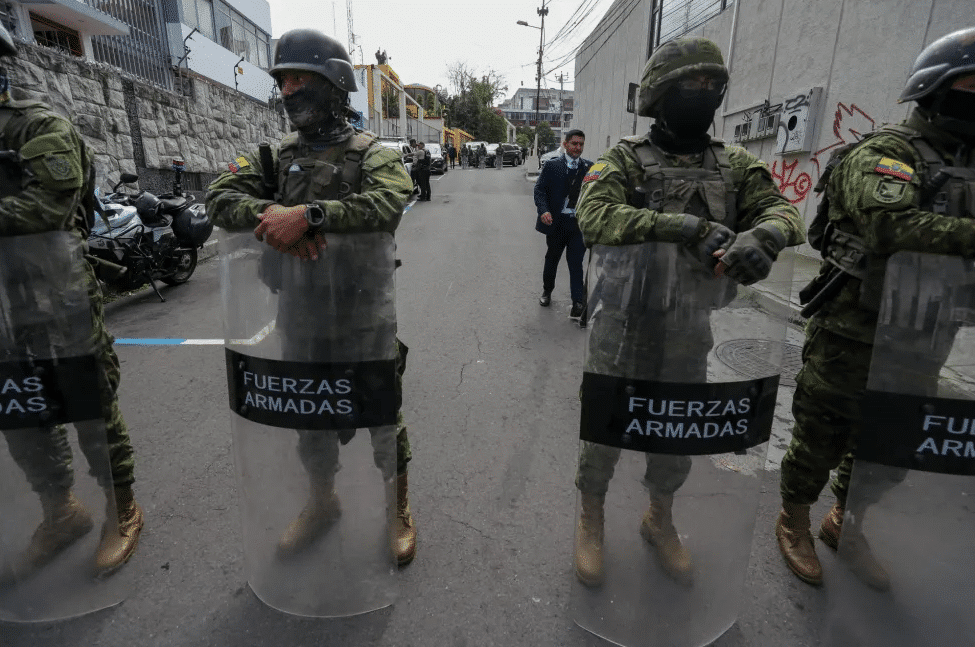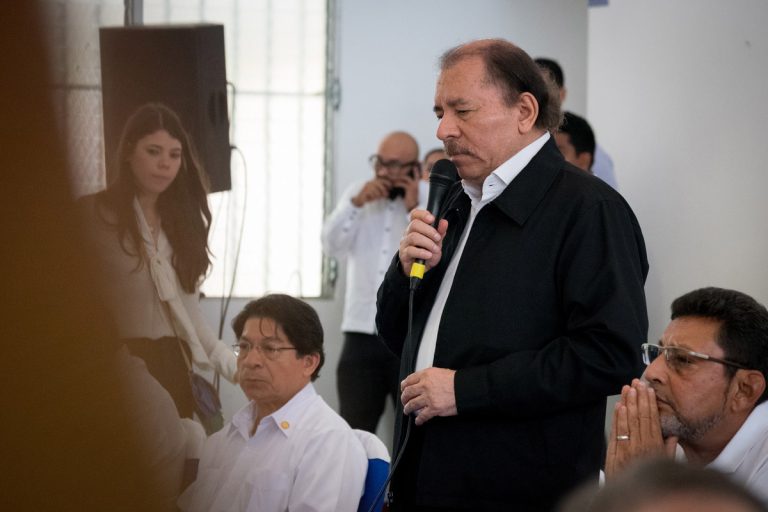10 de junio 2018

The Return of the Military

PUBLICIDAD 1M
PUBLICIDAD 4D
PUBLICIDAD 5D
The peaceful revolution demands a Constitutional way out and early elections, but with justice served and without Ortega in power

MESENI inicia labores: Se reunió con Alianza Cívica
On December 10, 2000, a time when Comandante Daniel Ortega was leading the opposition against president Arnoldo Aleman, I interviewed him on the program Esta Semana [This Week]. In the course of this interview, he defended the right to civic struggle as the most effective means for changing an unpopular government and president. Ortega made reference to the popular protests against Aleman’s corrupt government that the Sandinista Front was leading and boasted that “after so much marching all over the country in a very heated atmosphere,” only “one policeman was seriously wounded (in Diriamba) and a member of the Sandinista Front ended up a paraplegic.”
Ortega at that time was still governing “from below”. He had negotiated a constitutional reform with Aleman that dismantled the Constitution that had been amended in 1995, suppressed the right of Movements for Popular Inscription to put candidates on the ballot, and via a pact for mutual benefits with the Liberal Constitutional Party divided up the control of the state powers. Like a suit tailored to his measure, this same reform modified the norm for an electoral run-off vote, so that a presidential election could be won in the first round with only 35% of the votes.
During the interview, Ortega spoke of the fall of Ecuadorian President Jamil Mahoud which had occurred that same year, calling it an example of civic struggle. He added: “If we had marched to the president’s office in a peaceful way, as happened in Ecuador, that’s not violence; people marched peacefully, not one person died, they reached parliament and right to the president’s office. The president had to go and not one person died, and later there was a peaceful transition without breaking with the constitutional framework.”
Eighteen years later, after having remained in power for eleven, leading a corrupt regime that demolished the democratic institutions and concentrated all of the state powers under his control, Ortega had the opportunity to corroborate his supposed democratic convictions regarding civic struggle. He failed completely. The authoritarian strongman, who in 2007 swore in the name of the “people as president” to govern without opposition, has unmasked himself in a bloody way.
Faced with an unarmed civic rebellion that for the last 50 days has demanded his exit from power, his family dictatorship has provoked over 127 deaths and thousands of injured. And this has happened even though the “miniscule-vandalizing-
This bunker, which holds the FSLN Secretariat, the presidential office and his private residency, is guarded by more than 24 metal blockades within a perimeter of approximately one square kilometer. Each roadblock in turn is protected by stone walls and enormous spikes to pierce tires. All of this is watched over by hundreds of police and soldiers from the Army’s special forces.
Will the Police shoot at the demonstrators when they push against the barricades to advance towards El Carmen in peaceful protest, just as the paramilitaries attacked with impunity the youth that approached the National Engineering University during the Mother’s Day march? Will the Army add itself to the repression, or will it fulfill its promise of not taking up guns against the people?
Will the Army pawn their future with the messianic ambitions of the presidential couple, or will it play a stabilizing role, sticking to the Constitution when it comes their turn to decide between Ortega-Murillo and their own interests as an institutional body? These are the dilemmas being debated today in Nicaragua. The country has already crossed over the line of an intolerable situation; now the fortunes of this civic rebellion, citizen strike, national dialogue and a thousand other methods of general protest, have been cast on Ortega’s exit from El Carmen.
Up until yesterday, all of the influential national economic figures and international forces advocated for a solution that involved electoral reforms and early elections, cutting back on the presidential term but maintaining Ortega and Murillo in power. The premise of this theoretical imagining on the part of those who apparently never heard the shouting in the streets demanding, “Get them out!” is that this was the way to guarantee a constitutional succession, avoiding anarchy and a vacuum of power, because in contrast to 1979 this revolution didn’t propose to defeat the dictator of the moment, but to depose him in a peaceful manner. Nevertheless, the new version of the “soft landing” for Ortega in 2019 or 20, has at least three black holes revealing its unfeasibility.
The first hole was demonstrated this Thursday by the fiasco of Ortega’s meeting with the bishops: the presidential couple continue to isolate themselves from reality and from the misrule that they’ve brought about. Simply stated, the dictator isn’t willing to give up anything in terms of seeking justice for the crimes committed. In terms of democracy, he’s offered very little and very late. In his own worst-case scenario, perhaps, Ortega imagines himself out of the presidency for some years, but still governing “from below” with his paramilitary bands and shock forces. No one knows first-hand of Ortega’s intransigence better than the bishops of the Catholic Church, who represent the moral conscience of the nation. He grudgingly called them in to mediate only when his dictatorship is at the point of collapse, and, despite that fact, he persists in clutching onto power at all costs.
Second is the problem of political viability. In the hypothetical case that Ortega whould accept the critical path of political reforms, what stability can a morally and politically unfit president offer to the country, after having ordered – together with his wife – the worst killing spree in Nicaragua’s peacetime history? Can they possibly think that the mothers’ grief, the demands of the families, not only to know who killed their children and who gave the orders to kill, but also to have justice served and no one set above the law, can be ignored?
Ortega and Murillo can’t escape the national outcry for accountability and justice, and if for any force of greater good their exit from power involves their residing temporarily outside the country, an amnesty can never be emitted to cover them or exonerate them for their crimes against humanity. In the transition that is approaching, justice and democracy will surely be two different dynamics, but in the end they form part of the same political process in which one thing can’t be sacrificed for the other, much less with more impunity.
Finally, it’s absolutely false that having Ortega continue in his post during the transition until he can turn power over to another elected president is the only form of assuring a legal and constitutional solution. As well-known constitutional lawyers have already explained, the Ortega constitution itself established the legal route. According to this, once the president’s and vice president’s resignations have been accepted, and the current president of the National Assembly has been ruled out as a successor due to his involvement in the repression and corruption, Parliament can elect a president to head up the transition government while early elections are organized.
It won’t be difficult in the national dialogue to negotiate the selection of a provisional president, even one chosen from among the regime’s deputies, who would offer much more political and economic stability to the country than the current leaders whose hands are stained with blood. As student Lesther Aleman warned the day he silenced forever the official monologue: what needs to be negotiated in the national dialogue table are the terms of the regime’s surrender, a surrender arising not through an armed insurrection but, yes, through total civic rebellion.
On Thursday, June 7, abusing the good faith of the bishops from the Episcopal Conference, Ortega lost his opportunity to behave as a statesman who, notwithstanding his grave political errors, would make a last moment contribution to avoiding more bloodshed. He asked for two days to “reflect” on the agenda for “democratization” that was presented over two weeks previously in the national dialogue, but he didn’t announce an end to repression nor the dissolution of the paramilitary bands. Four hours later, the repression took another life in the National Autonomous University, nineteen-year-old Chester Javier Chavarria. It’s imperative that they put the brakes on the escalating violence in these 48 hours. The peaceful revolution is demanding a constitutional way out and early elections, but one with justice and without Ortega in power. And this will only be possible by intensifying the civic protest in all forms, until the dictator leaves his bunker in El Carmen.
Archivado como:
PUBLICIDAD 3M
Periodista nicaragüense, exiliado en Costa Rica. Fundador y director de Confidencial y Esta Semana. Miembro del Consejo Rector de la Fundación Gabo. Ha sido Knight Fellow en la Universidad de Stanford (1997-1998) y profesor visitante en la Maestría de Periodismo de la Universidad de Berkeley, California (1998-1999). En mayo 2009, obtuvo el Premio a la Libertad de Expresión en Iberoamérica, de Casa América Cataluña (España). En octubre de 2010 recibió el Premio Maria Moors Cabot de la Escuela de Periodismo de la Universidad de Columbia en Nueva York. En 2021 obtuvo el Premio Ortega y Gasset por su trayectoria periodística.
PUBLICIDAD 3D